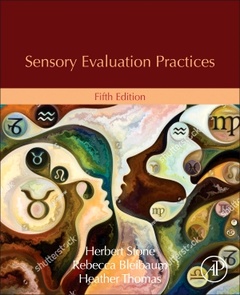Description
Sensory Evaluation Practices (5th Ed.)
Language: English480 p. · 19x23.3 cm · Paperback
Description
/li>Contents
/li>Readership
/li>Biography
/li>Comment
/li>
Sensory Evaluation Practices, Fifth Edition, presents the latest developments and methods of sensory evaluation, including those on the front end of innovation, consumer acceptance/preference, multivariate statistical analysis, discrimination testing, descriptive analysis, sensory claims substantiation for advertising, and information management. Additionally, related social psychological methods, such as laddering, design thinking, emotional profiling, and applications of qualitative and consumer co-creation and immersive techniques are explored. This book will be an ideal reference for sensory professionals, technical managers, product specialists and research directors in the food, beverage, cosmetics, and other consumer products industries of all sizes.
1. Introduction to Sensory Evaluation2. The Organization and Operation of a Sensory Evaluation Program3. Measurement4. Test Strategy and Design of Experiments5. Discrimination Testing6. Descriptive Analysis7. Consumer Affective Testing8. Business Applications (Expanded)9. How to Get Your Research Published10. Epilogue
Those working in product development, including sensory professionals, technical managers, product specialists and research directors in the food, beverage, cosmetics, and other consumer products industries of all sizes.
Rebecca N. Bleibaum, M.A., is President/Chief, Sensory Intelligence of Dragonfly SCI, Inc. a sensory and consumer insights research company in the San Francisco Bay Area, specializing in product testing and professional education. Bleibaum has over 25 years of experience in applied research from Tragon Corporation as their Chief Sensory Officer. She is co-developer and instructor of UC Davis Extension’s popular and long running “Applied Sensory & Consumer Science. In 2016, she was awarded the prestigious UC Davis Extension Outstanding Service Award for her contributions and dedication to the University's continuing education program. (www.dragonflysci.net)
Bleibaum is co-author of Sensory Evaluation Practices, Fourth Edition (2012), A Practical Guide to Comparative Advertising: Dare-to-Compare (est. 2018), previous Chair of ASTM International, Committee E-18 on Sensory Evaluation, has received five ASTM awards for contributions and the Award of Merit, has spoken at numerous professional events, and had given hundreds of impactful client presenta
- Emphasizes the importance of scientific sensory methodology used to measure and understand consumer perception
- Illustrates the importance of planning, managing and communicating product sensory information in a way that is actionable to developers, marketers and legal counsel
- Presents how sensory science is becoming more influential at the front end of innovation
- Discusses measurement, the design of experiments, and how to understand key sensory drivers that most influence consumers
- Explores the global nature of products and how companies can benefit by having fundamental training programs in sensory and consumer science
- Contains demonstrated methods for test selection, application and measurement, and testing with the right consumer, including more typical usage environments
- Includes worked examples for interpreting and displaying results
- Features a new chapter on how to get your research published
These books may interest you

Sensory Evaluation Techniques 184.47 €




